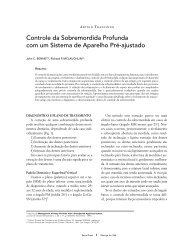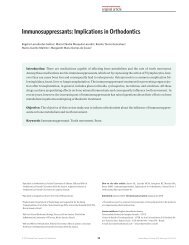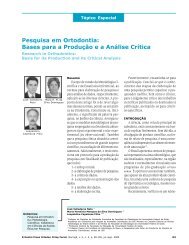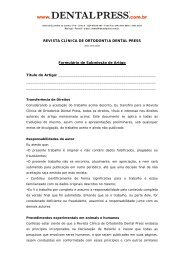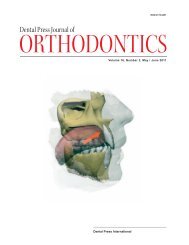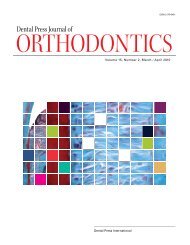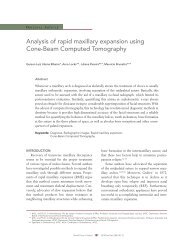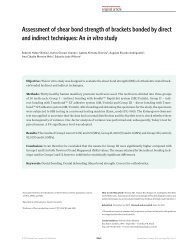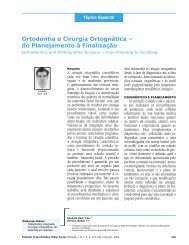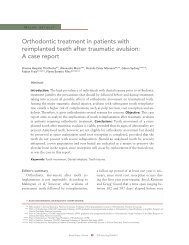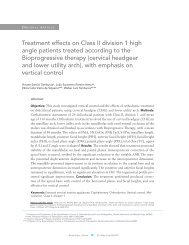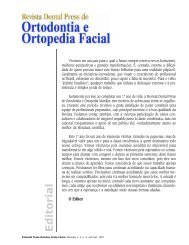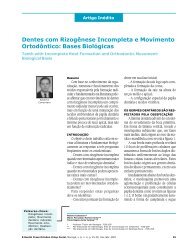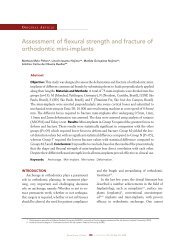Dental Press
Dental Press
Dental Press
Create successful ePaper yourself
Turn your PDF publications into a flip-book with our unique Google optimized e-Paper software.
Weckwerth PH, Siquinelli NB, Weckwerth ACVB, Vivan RR, Duarte MAH<br />
Introduction<br />
The Enterococcus genus includes members previously<br />
classified as Group D Streptococci due to the<br />
presence of Group D cell wall antigen, a glycerol<br />
teichoic acid associated with the cytoplasmic membrane.<br />
Enterococci are normal inhabitants of the gastrointestinal<br />
tract and are found in lesser amounts in<br />
the vagina and male urethra. 1<br />
These have become important pathogenic microorganisms<br />
in humans, mainly due to their resistance<br />
to antimicrobial agents and to recently studied virulence<br />
factors. 2<br />
These Gram-positive cocci are arranged as pairs or<br />
in small chains, and are very hard to differentiate from<br />
streptococci. They are facultative anaerobes that thrive<br />
at 35 o C, typically growing on the surface of blood agar<br />
plates as gamma-hemolytic cultures and on M-Enterococcus<br />
agar medium as deep-red or purplish colonies.<br />
Enterococci are tolerant to bile at 40% and can hydrolyze<br />
esculin. Moreover, they are able to grow in the<br />
presence of 6.5% sodium chloride, and can be distinguished<br />
from bacteria in genus Staphylococcus by their<br />
inability to produce catalase. 3<br />
Enterococcus faecalis are frequently found in root canals<br />
after failed endodontic therapy. 4,5,6<br />
Being highly resistant to several medications, they<br />
are also among the few microorganisms that display<br />
in vitro resistance to calcium hydroxide. This resistance<br />
is related to a proton pump 7 or to biofilm formation.<br />
8 In an attempt to overcome this resistance,<br />
the addition of different substances to calcium hydroxide<br />
has been proposed.<br />
One of the additives suggested is chlorhexidine, a<br />
biguanide. Calcium hydroxide-chlorhexidine paste has<br />
shown better antimicrobial action in vitro, compared<br />
with calcium hydroxide paste with pure water. 9 Despite<br />
its positive antimicrobial effect, this association<br />
has shown greater peroxide ion release, resulting in<br />
greater tissue irritation. 10<br />
New alternatives have been proposed in endodontic<br />
therapy, including natural substances such as propolis<br />
and phytotherapeutic agents. One of these phytotherapeutic<br />
agents is Casearia sylvestris Sw infusion or<br />
alcoholic extract.<br />
This plant is native to Latin America, from Mexico to<br />
Argentina. It is found throughout Brazil, being particularly<br />
common in the state of São Paulo. It is popularly<br />
known as guaçatonga, erva de lagarto (“lizard’s herb”),<br />
vassitonga, bugre branco, among other names. The<br />
word “guaçatonga” originated from the Tupi-Guarani<br />
(indigenous language), showing that this species was<br />
known by the native populations of Brazil. 11<br />
Guaçatonga extract has shown antiinflamatory 13<br />
and antimicrobial action. 14 However, no studies showing<br />
whether the addition of phytotherapeutic agents to<br />
calcium hydroxide paste interferes with its antimicrobial<br />
action can be found in the scientific literature.<br />
With this in mind, the objective of the present<br />
study was to evaluate the sensitivity of several Enterococcus<br />
faecalis strains isolated from the oral cavity<br />
to direct contact with calcium hydroxide pastes associated<br />
with Casearia sylvestris Sw (guaçatonga) in propylene<br />
glycol, calcium hydroxide with pure propylene<br />
glycol, or calcium hydroxide and 1% chlorhexidine in<br />
propylene glycol.<br />
Metodology<br />
Preparation of the extract<br />
The Casearia sylvestris Sw leaves used in this study<br />
were collected at the Lageado farm, School of Agronomical<br />
Sciences - Unesp, in Botucatu, state of São<br />
Paulo, and identified at the herbarium of the Sagrado<br />
Coração University (USC) - Bauru, São Paulo, Brazil.<br />
After harvesting and desiccation, the material was<br />
further dehydrated in an air-circulating oven under<br />
controlled temperature until constant weight was<br />
achieved. Following that, the leaves were triturated<br />
in a knife mill and used to prepare the extract. The<br />
dehydrated material was macerated in propylene glycol<br />
(extracting solution) following a ratio of 25 grams<br />
of powder to 200 ml of extracting solution. The plant<br />
powder remained in the extracting solution for eight<br />
days, with sporadic agitation during that period. The<br />
entire extraction process took place in an amber colored<br />
container (in order to prevent possible interference<br />
by light) and at room temperature (25ºC).<br />
Enterococccus Strains<br />
Forty E. faecalis strains from the USC Microbiology<br />
laboratory bacterial library were used in the present<br />
work. These strains were cultured from bacterial<br />
samples obtained from the oral cavity of patients seen<br />
at the USC School of Dentistry Endodontics clinic in<br />
Bauru, Brazil.<br />
© 2011 <strong>Dental</strong> <strong>Press</strong> Endodontics 47<br />
<strong>Dental</strong> <strong>Press</strong> Endod. 2011 apr-june;1(1):46-51



